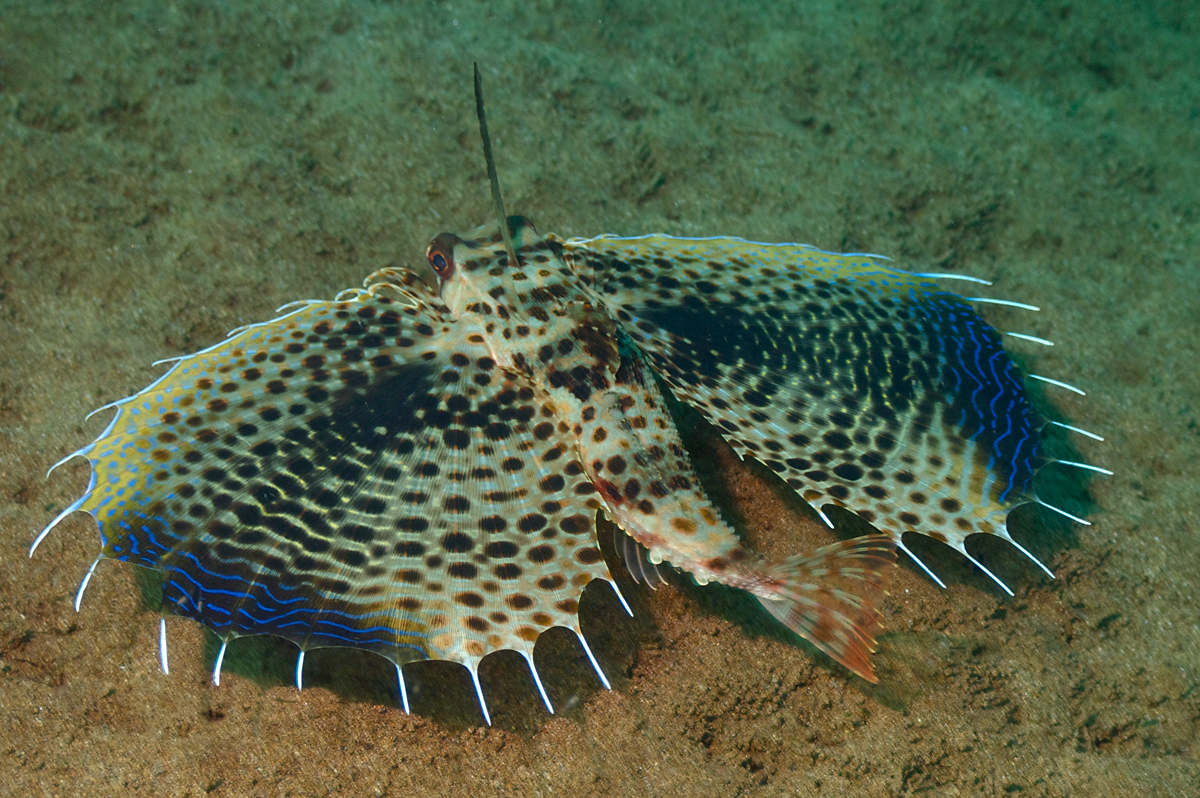Purple Flying Gurnard, Dactyloptena orientalis (Cuvier 1829)
Other Names: Flying Gurnard, Indo-Pacific Flying Gurnard, Oriental Helmet Gurnard, Oriental Searobin, Purple Flying-gurnard

A Purple Flying Gurnard, Dactyloptena orientalis, at Dumaguete, Bacong, Central Visayas, Philippines. Source: Elias Levy / Flickr. License: CC BY Attribution
Summary:
A greyish to pale brown helmet gurnard with large, dark-edged brown spots on the upper surface, and numerous orange to brown spots and wavy blue lines on the large pectoral fins.
Video of a Purple Flying Gurnard
Video of a Purple Flying Gurnard
Cite this page as:
Bray, D.J. 2022, Dactyloptena orientalis in Fishes of Australia, accessed 19 Apr 2024, https://fishesofaustralia.net.au/home/species/4640
Purple Flying Gurnard, Dactyloptena orientalis (Cuvier 1829)
More Info
|
Distribution |
Recorded in Australia from north of Geraldton, Western Australia, around the tropical north to Merimbula, southern New South Wales; also the Lord Howe Province in the Tasman Sea. Elsewhere the species is widespread in the tropical Red Sea and Indo-west-central Pacific: Red Sea, Persian Gulf and east Africa, to Hawaii and the Pitcairn Group. Inhabits sandy areas in coastal waters, including around oceanic islands. This well-camouflaged solitary fish uses its pelvic and pectoral-fin rays to move slowly over the seafloor. |
|
Features |
Dorsal fin I+I+V+9; Anal fin 6-7; Pectoral fin 32-35; Pelvic fin I, 4-5; Lateral scale series 45-47. Body heavily amoured, somewhat box-like, with large wing-like pectoral fins, each fin-ray with short-filaments extending along outer margin; fins reaching caudal-fin base or beyond when folded. |
|
Feeding |
Feeds mostly on crustaceans, bivalve molluscs, and small fishes. |
|
Etymology |
The specific name is from the Latin orientalis (= eastern, of the east), in reference to the type locality. |
|
Species Citation |
Dactylopterus orientalis Cuvier, 1829, Le Règne Animal 2 : 162. Type locality: Coromandel coast, India, eastern Indian Ocean (as Mer des Indies). |
|
Author |
Bray, D.J. 2022 |
|
Resources |
Purple Flying Gurnard, Dactyloptena orientalis (Cuvier 1829)
References
Allen, G.R. 1997. Marine Fishes of Tropical Australia and South-east Asia. Perth : Western Australian Museum 292 pp. 106 pls.
Allen, G.R. & Erdmann, M.V. 2012. Reef fishes of the East Indies. Perth : Tropical Reef Research 3 vols, 1260 pp.
Allen, G.R. & Swainston, R. 1988. The Marine Fishes of North-Western Australia. A field guide for anglers and divers. Perth, WA : Western Australian Museum vi 201 pp., 70 pls.
Cuvier, G.L. 1829. Le Règne Animal Distribué d'après son Organisation, pour servir de base à l'histoire naturelle des animaux et d'introduction à l'anatomie comparée. Poissons. Paris : Fortin, Masson et Co. Vol. 2 Ed. 2, pp. 122-406 See ref at BHL
Eschmeyer, W.N. 1997. A new species of Dactylopteridae (Pisces) from the Philippines and Australia, with a brief synopsis of the family. Bulletin of Marine Science 60(3): 727-738.
Francis, M.P. 1993. Checklist of the coastal fishes of Lord Howe, Norfolk, and Kermadec Islands, southwest Pacific Ocean. Pacific Science 47(2): 136-170 figs 1-2
Francis, M.P. 2019. Checklist of the coastal fishes of Lord Howe, Norfolk and Kermadec Islands, southwest Pacific Ocean Version: 2019.1 https://doi.org/ 10.6084/m9.figshare.c.4428305
Grant, E.M. 2002. Guide to Fishes. Redcliffe : EM Grant Pty Ltd 880 pp.
Johnson, J.W. 2010. Fishes of the Moreton Bay Marine Park and adjacent continental shelf waters, Queensland, Australia. pp. 299-353 in Davie, P.J.F. & Phillips, J.A. Proceedings of the Thirteenth International Marine Biological Workshop, The Marine Fauna and Flora of Moreton Bay. Memoirs of the Queensland Museum 54(3)
Jordan, D.S. & Richardson, R.E. 1908. A review of the flatheads, gurnards, and other mail-cheeked fishes of the waters of Japan. Proceedings of the United States National Museum 33(1581): 629-670 figs 1-9
Kuiter, R.H. 1993. Coastal Fishes of South-eastern Australia. Bathurst : Crawford House Press 437 pp.
Kuiter, R.H. 1996. Guide to Sea Fishes of Australia. A comprehensive reference for divers and fishermen. Sydney, NSW, Australia : New Holland Publishers xvii, 434 pp.
Larson, H.K., Williams, R.S. & Hammer, M.P. 2013. An annotated checklist of the fishes of the Northern Territory, Australia. Zootaxa 3696(1): 1-293.
Motomura, H. & Matsuura, K. 2016. Dactyloptena orientalis. The IUCN Red List of Threatened Species 2016: e.T50903234A53990827. http://dx.doi.org/10.2305/IUCN.UK.2016-3.RLTS.T50903234A53990827.en. Downloaded on 16 June 2018.
Ogilby, J.D. 1910. On new or insufficiently described fishes. Proceedings of the Royal Society of Queensland 23(1): 1-55. (described as a new species Ebisinus procne)
Poss, S.G. & Eschmeyer, W.N. 1999. Family Dactylopteridae. pp. 2283-2290 in Carpenter, K.E. & Niem, T.H. (eds). The Living Marine Resources of the Western Central Pacific. FAO Species Identification Guide for Fisheries Purposes. Rome : FAO Vol. 4 pp. 2069-2790.
Randall, J.E. 2005. Reef and shore fishes of the South Pacific. New Caledonia to Tahiti and the Pitcairn Islands. Honolulu : University of Hawaii Press 707 pp.
Randall, J.E., Allen, G.R. & Steene, R. 1990. Fishes of the Great Barrier Reef and Coral Sea. Bathurst : Crawford House Press 507 pp. figs.
Randall, J.E., Allen, G.R. & Steene, R. 1997. Fishes of the Great Barrier Reef and Coral Sea. Bathurst : Crawford House Press 557 pp. figs.
Sainsbury, K.J., Kailola, P.J. & Leyland, G.G. 1985. Continental Shelf Fishes of Northern and North-Western Australia. Canberra : Fisheries Information Service 375 pp. figs & pls.
Whitley, G.P. 1929. Studies in Ichthyology No. 3. Records of the Australian Museum 17(3): 101-143 figs 1-5 pls 30-34
















